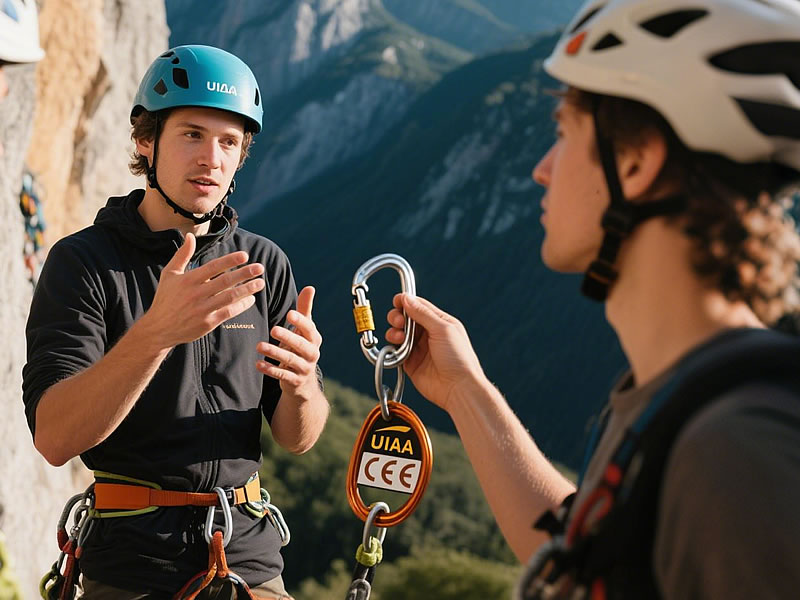UIAA vs CE certification for climbing carabiners
When your life depends on a carabiner, certifications matter—but not all standards are equal. The UIAA (International Climbing and Mountaineering Federation) and CE (Conformité Européenne) logos both appear on climbing gear, yet their testing protocols and safety philosophies differ starkly. Understanding these distinctions could mean the difference between a safe catch and catastrophic failure.

What UIAA and CE Certifications Actually Mean
- UIAA: Developed by climbers, for climbers, the UIAA focuses exclusively on mountaineering equipment. Its standards are updated annually based on accident reports and lab research.
- CE: A broader EU safety framework covering everything from helmets to kayaks. CE marks indicate compliance with the EN 12275:2013 standard for climbing gear but prioritize general outdoor use over climbing-specific stresses.
Key Differences in Testing Protocols
| Test Criteria | UIAA Standard | CE Standard (EN 12275) |
|---|---|---|
| Major Axis Strength | ≥20 kN | ≥15 kN |
| Gate Open Strength | ≥7 kN | ≥6 kN |
| Gate Cycles | 15,000+ | 5,000 |
| Dynamic Load Testing | Mandatory | Optional |
| Corrosion Resistance | Salt spray + 28-day test | Basic humidity test |
The UIAA’s dynamic load test simulates real climbing falls by dropping a 80kg weight 5 meters onto the carabiner. CE skips this test, relying instead on static pulls.
Why UIAA Certification Matters More for Climbers
- Gate Durability: A UIAA carabiner survives 3x more gate cycles than CE requires. Worn gates cause 23% of carabiner failures (UIAA Safety Commission).
- Side-Load Safety: CE allows 15 kN major axis strength—enough for via ferrata but risky for lead falls generating 8-12 kN.
- Real-World Simulation: UIAA tests carabiners with rope drag and icy conditions; CE tests in lab-perfect environments.
When CE Certification Suffices
CE-certified gear works for:
- Non-technical use: Backpack clips, dog leashes, via ferrata lanyards.
- Casual climbing: Indoor gyms with controlled falls.
- Budget constraints: CE carabiners cost 20-40% less than UIAA models.
Top Brands and Their Certifications
| Brand | UIAA-Certified Models | CE-Only Models |
|---|---|---|
| Petzl | SPIRIT, WILLIAM | ANGE L |
| Black Diamond | ROCKSOCKET | HORNET |
| Edelrid | STRIKE SL | APUS |
Note: Some brands (e.g., DMM) UIAA-certify all carabiners.
The Hidden Risks of CE-Only Carabiners
- False economy: A €10 CE carabiner fails at 15 kN—below the 18 kN force of a 1.5-factor fall.
- Corrosion gaps: CE’s humidity test ignores saltwater exposure, a known killer of coastal climbers’ gear.
- No recall system: UIAA publicly tracks defective gear; CE relies on manufacturers to self-report.
How to Spot Fake Certifications
- Check logos: UIAA labels include a certification code (e.g., UIAA 121).
- Verify online: Cross-reference serial numbers on UIAA’s database.
- Avoid “CE” stickers: Legitimate CE marks are engraved or stamped.
Expert Opinions
“UIAA standards are the gold standard. CE is like buying a bicycle helmet rated for skateboarding—it might work, but why gamble?”—John Evans, IFMGA Guide & Gear Designer
The Future of Climbing Certifications
The UIAA is pushing for:
- Ice/mixed-specific tests: Simulating freeze-thaw cycles on gates.
- AI-powered wear analysis: Apps to scan carabiners for micro-fractures.
- Sustainability standards: Tracking recycled aluminum content.
While CE certification meets legal requirements, UIAA certification reflects climbing’s unique demands. For lead climbers, ice adventurers, or anyone pushing limits, UIAA’s rigorous testing is non-negotiable. As legendary alpinist Reinhold Messner once said: “The mountains don’t care about your excuses—only your preparation.”






